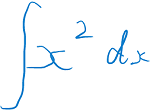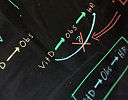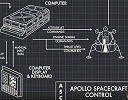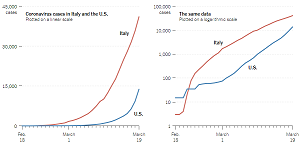IntMath Newsletter: Farewell, online math resources
By Murray Bourne, 27 Mar 2020
27 Mar 2020
In this Newsletter:
0. Fond farewell
1. Math in the news
2. Resource: ClassCalc
3. Math movie
4. Math art and code
5. Math puzzle
6. Final thought: Reset
0. Fond farewell
After much deliberation, I've decided to sell IntMath. It's been a huge part of my life for the past 23 years and I've loved every minute of developing it. However, my back, butt and legs can't take the punishment of sitting for endless hours any more, so I really need to let it go.
I'll hand over to the new owner of IntMath, Nick La Maina, to introduce himself and his company, and to give you an idea of how he intends to take IntMath to new heights.
Hey folks,
This is Nick, one of IntMath's new owners. I just wanted to say how excited we are to take IntMath to the next level. Our team has started a handful of internet companies, nearly all of which were focused around community and education, and we were incredibly impressed at the loyal following Murray has created around math. Our largest education site to date is encyclopedia.com and we look forward to taking some of those learnings and applying them to IntMath.
Many of you have used IntMath for years and may be thinking to yourself: I hope these guys don't screw up a website that I already love.
Don't worry...we don't have any major changes in mind, yet.
Our plan is to improve IntMath using this community's insights, feedback, and opinion.
And so, to kick things off, I'd love it if you could tell me why you use IntMath, and what you want us to improve.
Newsletter Re-subscribe
We will continue to send out newsletters that include math resources, games, news, and competitions. The good news is they will be very similar to what you have received in the past from Murray. You will also be the first to know of any exciting new updates and features coming to IntMath.
If you’d like to continue to receive the IntMath newsletter, please sign up here: Sign up for the new Newsletter
Please note you need to re-subscribe to receive the new IntMath newsletter.
Alright...talk soon. If you need to reach me, please email me at [email protected].
- Nick
1. Math in the News
(a) Teaching math online
Teachers world-wide have been thrust into unfamiliar territory where they need to develop and deliver online lessons. Most of us go into teaching because we love the day-to-day interaction with students, but the relative isolation of running a class without even seeing the students can be daunting.
The key principles of effective online learning are really the same as offline - put an emphasis on the skills you want students to develop, rather than concentrating on the knowledge (facts) you want them to know. Learning facts can be boring enough in a classroom - it's even more so in an online environment. So the key thing is to design (or find) meaningful activities where students are challenged to learn by solving problems.
I mentioned the Desmos Classroom Activities recently. The idea here is students work on solving geometric challenges, but in the process gain valuable insights into important graph concepts. The approach can be applied to paper-based activities in cases where students don't have ready access to phones or computers.
A lot of students have reported how much they enjoy working through the Khan Academy lessons. They like how tracking their progress helps with motivation. Khan lessons tend to be more of the "watch a video then answer some questions on it" variety compared to Desmos' more nuanced (and thoughtful) approach, but it certainly has some good lessons.
Another thing to consider is to design activities where studens do a project making use of items or events at home, drawing out mathematics concepts from them ('real-life' math). So for example, their father may be tiling a floor (area), or mixing paint (proportions), or their little brother is using a trampoline (parabolic arcs, velocity, acceleration). Students could make short videos of their discoveries and by sharing them, everyone in the class learns.
A key thing is students won't expect the lessons to be perfect, but they will appreciate them if they are interesting, require creativity and they can realize they are making progress.
Teachers have reported difficulty making their math handwriting to be readable when conducting an online session (or making a video). One of several options to solve this is Myscript, which converts handwritten math into "real" mathematics. This Myscript webdemo shows it in action.
As an example, I just wrote this (quite ugly) expression using a mouse in their Webdemo ...

... and it happily converted it to this:
![]()
Using a stylus is of course much easier and quicker, and students will be able to see the converted math almost instantly. Myscript also plots the graph of an expression (if it recognizes it).
(b) COVID-19 exponential curve and logarithmic scales
There are currently many graphs in the media describing the pandemic. What's obvious is many politicians do not understand exponential growth and have left their responses way too late.
It's also important to be able to interpret graphs with a logarithmic axis (usually the number of cases, or number of deaths) versus a linear axis (usually time in days or weeks).
This article from New York Times gives some insight:
A Different Way to Chart the Spread of Coronavirus
(c) Correlation and causation
It's well known that the number of cases of sunburn increase with the consumption of ice cream. But does eating ice cream cause sunburn? There's always a danger that scientists conclude causation (this causes that) when in fact, the situation would be better described as correlation (two variables happen to move together in the same direction).
 |
A team of Iraqi scientists have used AI to give a better idea on whether we have causation or correlation. See: New AI Can Reliably Spot When Correlation Really Does Mean Causation |
(d) Not a 'math person'? You may be better at learning to code than you think
 |
I always assumed math ability was important for coding, but this article suggests otherwise: |
2. Resource: ClassCalc
Hand-held calculators don't make a lot of sense if students already have smart phones (and they're allowed to bring them to school). Here's an alternative to calculators which could reduce cost.
ClassCalc is a mobile-friendly online "lockdown" calculator with the following facilities:
- Scientific calculator (the usual log, sin, square root, etc)
- Matrix operations (find inverses, multiply, etc)
- Graphing (appears to be similar to Desmos)
The calculator can be used in assessment situations since it disables Internet access and apps
It's worth a look.
3. Math Movie
How one woman put man on the moon
The movie Hidden Figures told the story of three female African-American mathematicians who played a key role in the US space race in the 1960s.
 |
Here's the story of another woman who contributed to that race via her brilliant use of very limited computing power. |
4. Math art and code
Here are some examples from CodePen, which is an online code editor with a helpful community.
| Example | Description | See the code |
|---|---|---|
| Calculating π using raindrops | One way to approximate π is to count the number of equal-sized objects randomly falling on a circle divided by those falling on a square, multiplied by 4. This animation illustrates this. | Code |
| The Standard-agnostic Clock | Most of us are used to analog clocks with 12 at the top and the hands going clockwise. What if we mess about with this? | Code |
| SVG Turbulence Animation | Beautiful and gentle SVG animations | Code |
| Morphing animals | Makes clever use of triangulation | Code |
| Multiple Lissajous figures | I love this display of multiple figures based on multiple different ratios. Drag the graphs to see way more. | Code |
| Torus | You can drag this 3D semi-transparent torus with psychedelic markings | Code |
5. Math puzzle
The puzzle in the last Newsletter involved calculating the distance between two poles given the length of rope joining them. Correct solutions with sufficient reasons were provided by: Thomas, Trevor, Chris, and John.
Apparently this question is given as a job interview question at Amazon. The key thing they are looking for is people who look at the big picture first (and perhaps do back of the envelope estimates) rather than those that have technical skill only and dive straight into solving it using calculus or whatever.
It's a good thing for us all to keep in mind when solving life's problems.
6. Final thought - Reset
The events overtaking the world due to the pandemic should give us all pause to think about how we'll proceed once it subsides. Being such a dramatic event, it will surely result in major new ways of thinking about things. Perhaps (and yes, I'm the eternal optimist):
- We'll solve a lot of energy issues by travelling less.
- We'll learn and work in new ways.
- We'll value real relationships over divisive virtual ones.
- We'll value expertise and facts over opinions.
- We'll appreciate cleaner skies, cleaner air and cleaner water, and will do what we can to keep those in place.
- We'll realize a circular economy is the only way forward, and that exponential economic growth in a finite world is impossible.
- We'll work together to address climate issues before they're thrust on all of us.
- We'll realize we're all one family and that looking after each other far exceeds "every man for himself" in outcomes.
Thank you for being loyal subscribers to the IntMath Newsletter and for all the positive feedback over the years.
Until we meet again, enjoy whatever you learn.
See the 24 Comments below.

27 Mar 2020 at 3:22 pm [Comment permalink]
Dear Murray,
So sorry to learn you have to sell IntMath because of 'back, butt and legs' 🙂
I can relate to that as a computer teacher who has spent countless hours glued in front of a PC.
Thank you for everything, Murray.
Blessings,
Rechad
27 Mar 2020 at 3:25 pm [Comment permalink]
Farewell, again, dear Murray.
And thanks to Nick for carrying on.
Kind Regards,
Rechad
27 Mar 2020 at 6:38 pm [Comment permalink]
Dear Professor Murray Bourne,
I just can say thank you very much because You have done a brilliant job and IntMath News Letter has been helpful to me due I work as a Electronics Maintenance Engineer.
I wish You the best.
Good Luck !
Bruno Bonvini
Sao Paulo - Brazil
27 Mar 2020 at 6:40 pm [Comment permalink]
I join with you with your final hopes for the future.
27 Mar 2020 at 9:41 pm [Comment permalink]
Thank you so much for your rich and intelligent resources. IntMath has never failed to inform and spark curiosity. I am so sorry to see you go and sincerely wish you the best.
Your message about waking up to the climate issues and rethinking our need to be people amongst other people is wonderful. I wish I could share your optimism, but I sincerely hope that you are right.
Enjoy your new freedom and again, I hope that you have much joy and fulfillment in your life, much as IntMath has helped others to do so as well.
Best regards,
L
27 Mar 2020 at 10:58 pm [Comment permalink]
Thanks for your help and service. You have done a great job with making math fun and intriguing.
28 Mar 2020 at 12:31 am [Comment permalink]
I enjoyed this news letter very much for years.
I will miss it.
Even in this last news letter you give me the information which I was searching for some time. It is myScript demo.
Wish you healthy and happy life.
Thanks
Chiman Delwadia
28 Mar 2020 at 6:09 am [Comment permalink]
@Naran: Thank you for your kind thoughts. I'm glad you found Myscript useful.
28 Mar 2020 at 6:10 am [Comment permalink]
@David: You are welcome and thank you for the kind comments.
28 Mar 2020 at 6:10 am [Comment permalink]
@L: Thank you! It really makes me happy to know you found IntMath useful over the years.
28 Mar 2020 at 6:52 am [Comment permalink]
I was disappointed that I could not read the article from the Ney York Times without paying. This was the article discussing the difference in the linear graph and the logarithmic graph.
28 Mar 2020 at 8:38 am [Comment permalink]
Thank you for everything, Murray.
I already signed for the new Newsletter...
One **very important** Question:
- what will happen to all your wonderful collection of Interactive Calculators (in JS)??
Will they still be available normally
in the new IntMath website?.
It would be a terrible loss for all of us, loyal followers,
if your Interactive Calculators treasure
were lost...
28 Mar 2020 at 8:53 am [Comment permalink]
Thanks for the terrific contribution and News letter to Maths Education over the years.
Robert
Australia
28 Mar 2020 at 9:55 am [Comment permalink]
@Robert: Thank you - glad it was useful.
28 Mar 2020 at 9:56 am [Comment permalink]
@tester: As Nick said, they're not going to make any radical changes, at least for a start. I can't imagine why they'd remove the calculators.
28 Mar 2020 at 9:58 am [Comment permalink]
@Charlene: Oh, sorry about that. I was able to view it and I don't have a subscription. I think this may have been because I haven't viewed other NYTimes articles recently. (I think they let you do one article a month for free, or something like that.)
All the best to you and stay safe.
28 Mar 2020 at 6:37 pm [Comment permalink]
Thanks Murray,
You helped me a great deal when I wanted to write Maths on a web page.
Intmath was always the first place where I went to improve my teaching.
Enjoy your "retirement".
Regards
Rika
28 Mar 2020 at 8:00 pm [Comment permalink]
@Rika: You are very welcome. Keep well and safe!
29 Mar 2020 at 2:35 am [Comment permalink]
Dear Murray,
Congratulations! At 82, I realize that time does come when one needs to change, whether that be retirement or just to do something different. I have enjoyed your program and always learned something new. It's been a pleasure.
On a more mundane subject, I subscribed to your program via a particular website for members only. What will happen to that? This question also refers to all the CDs/DVDs that you recorded--what will happen to them?
Again, best of luck and have a great life,
John Vesey
29 Mar 2020 at 6:51 pm [Comment permalink]
@John: Thank you!
I believe you are referring to the MathTutorDVD program. It is independent of IntMath (different author - I just provided advertising space for his DVDs) and I don't believe he's going to stop that any time soon.
30 Mar 2020 at 10:52 am [Comment permalink]
Dear Murray.
In retirement, I hope that the torment of your
ailments will will be considerably relieved, if not banished.
Through the challenges and banter relating to the math
problems, and other topics, I have developed a sense of
knowing you, and the good intentions you stand for.
Well done, and a Gold Medal for all your great work in the past.
But looking forward to some other future contributions, as one
just cannot give up completely!
In modern life styles, the large number of hours being seated;
going to work, at work and leisure, contributes to neglect of the
physical body. Ban the chair? Advocate for a better physical/mental balance.
As an 81 year old, trying to stay active on both above fronts,
I thank you for your past efforts, and wish you a happy future.
Yours Thankfully,
Thomas A Buckley
31 Mar 2020 at 5:52 am [Comment permalink]
Thank you for providing such a varied and wonderful experience in Maths. Your news letter has keep me in touch and furthered in the wonderful world of mathematics.
Thanks again.
3 Apr 2020 at 10:19 am [Comment permalink]
Murray
Thanks for all over the years and wish you the best on your next venture/s.
31 May 2020 at 5:29 am [Comment permalink]
Well done over the years!
You've given great service